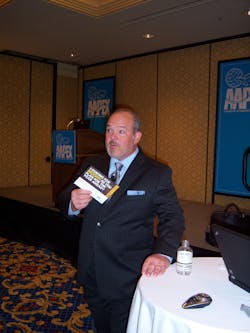Researcher claims consumer spending to hold strong for the automotive aftermarket at AAPEX Show
Nov. 2, 2012
Voice Your Opinion!
Voice Your Opinion!
Consumers are starting to spend more money since the recession began, but they aren't expected to reconsider holding onto their cars longer than they did prior to the recession, which means automotive aftermarket shops have a positive outlook. That was the message from David Portalatin, an industry analyst for the NPD Group, a research firm. Portalatin gave a well attended presentation at the Automotive Aftermarket Products Expo (AAPEX) at the Sands Expo Center in Las Vegas.
Consumers continue to be very concerned about the nation's economy and about their own personal financial situations, Portalatin said. "People need to start feeling better about their own personal situation" for this outlook to change," he said.
In 2012, consumer perception about both the economy and consumers' own personal finances improved slightly, Portalatin said. However, the pessimism remains at a higher level than it was before the recession.
One reason consumer spending has improved slightly is that inflation is forcing them to spend more money, he said.
The good news for the automotive aftermarket industry is that consumers expect to spend more on fuel and on vehicle repairs. Portalatin noted that his company studies a variety of industries and the automotive aftermarket has one of the best outlooks among all industries. He said spending on automotive products has increased 4 percent in 2012, which is one of the best performing industries.
Gasoline spending has not increased much despite higher gas prices, indicating consumers are driving less, he said.
Portalatin said fuel purchases have a big impact on overall consumer spending since the more spent on fuel the less is available for other areas.
New car purchases have increased, he noted, but not enough to offset the tendency among consumers to hold onto their existing vehicles longer. "The majority of American consumers are going to drive the same car in 2013 as in 2012," he said.
"That car's our new sweet spot," Portalatin said, referring to the opportunity today's cars offer for aftermarket spending. He noted that the average car is now 11 years old.
Delving deeper into the research, Portalatin said the 8-year-old and older cars are becoming more prevalent than the 4- to 7-year-old cars.
As for used car buying plans, he said these purchase intentions are slightly lower for 2013 than for 2012.
If the economy worsens, 37 percent of the current car purchasing plans will be abandoned.
Portalatin said miles driven have declined in recent years but should stabilize in 2013.
He noted that the decline in miles driven since 2007, when the recession began, marked a change from a steady 30-year growth trend.
Addressing the widely publicized increase in new car sales, Portalatin said there has been a robust growth in the new car segment in the last year compared to the early years of the recession. But this group of purchasers remain in the minority.
The opportunity for the automotive aftermarket is the large number of consumers who are willing to spend more on maintenance of older cars, Portalatin said. This indicates an opportunity for both the do-it-yourself market and the professional car care market, but more so for the latter.
NPD's research found that 66 percent of car owners will go to a professional while only 22 percent will do some of it themselves and 9 percent will do all the repairs themselves.
"These are value oriented customers," he said. He said they don't define value by price.
